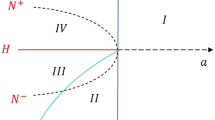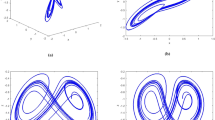Abstract
In this paper, we consider the traditional Van der Pol oscillator with a forcing dependent on a delay in feedback. The delay is taken to be a nonlinear function of both position and velocity, which gives rise to many different types of bifurcations. In particular, we study the Zero-Hopf bifurcation that takes place at certain parameter values using methods of center manifold reduction of DDEs and normal form theory. We present numerical simulations that have been accurately predicted by the phase portraits in the Zero-Hopf bifurcation to confirm our numerical results and provide a physical understanding of the oscillator with the delay in feedback.










Similar content being viewed by others
References
Atay, F.M.: Van der Pol’s oscillator under delayed feedback. J. Sound Vib. 218, 333–339 (1998)
Augusti, G.: Instability of struts subject to radiant heat. Meccanica 3, 167–176 (1968)
Beuter, A., Bélair, J., Labrie, C.: Feedback and delays in neurological diseases : a modeling study using dynamical systems. Bull. Math. Biol. 55, 525–541 (1993)
Bramburger, J., Dionne, B., LeBlanc, V.G.: Zero-Hopf bifurcation in the Van der Pol oscillator with delayed position and velocity feedback. arXiv:1402.5866, (2014)
Cartwright, J.H.E., Eguiluz, V.M., Hernandez-Garcia, E., Piro, O.: Dynamics of elastic excitable media. Int. J. Bifurcat. Chaos 9, 2197–2202 (1999)
de Oliveira, J.C.F.: Oscillations in a van der Pol equation with delayed argument. J. Math. Anal. Appl. 275, 789–803 (2002)
Edelman, K., Gendelman, O.: Dynamics of self-excited oscillators with neutral delay coupling. Nonlinear Dyn. 73, 683–694 (2013)
Faria, T., Magalhães, L.T.: Normal forms for retarded functional differential equations and applications to Bogdanov-Takens singularity. J. Differ. Equ. 122, 201–224 (1995)
Faria, T., Magalhães, L.T.: Normal forms for retarded functional differential equations with parameters and applications to Hopf bifurcation. J. Differ. Equ. 122, 181–200 (1995)
Guckenheimer, J., Holmes, P.: Nonlinear oscillations, dynamical systems, and bifurcation of vector fields. Springer-Verlag, New York (1983)
Hale, J.K., Verduyn Lunel, S.M.: Introduction to functional differential equations. Appl. Math. Sci., vol. 99. Springer, New York (1993)
Heil, T., Fischer, I., Elsäßer, W., Krauskopf, B., Green, K., Gavrielides, A.: Delay dynamics of semiconductor lasers with short external cavities: bifurcation scenarios and mechanisms. Phys. Rev. E 67, 066214-1–066214-11 (2003)
Holmes, P.J.: Bifurcations to divergence and flutter in flow-induced oscillations: a finite dimensional analysis. J. Sound Vib. 53, 471–503 (1977)
Ji, J., Zhang, N.: Additive resonances of a controlled Van der Pol-Duffing oscillator. J. Sound Vib. 315, 22–33 (2008)
Jiang, W., Yuan, Y.: Bogdanov-takens singularity in Van der Pol’s oscillator with delayed feedback. Phys. D 227, 149–161 (2007)
Kaplan, B.Z., Gabay, I., Sarafian, G., Sarafian, D.: Biological applications of the filtered Van der Pol oscillator. J. Franklin Inst. 345, 226–232 (2008)
Kuang, Y.: Delay differential equations with applications in population dynamics. Mathematics in science and engineering, 191st edn. Academic Press, Boston (1993)
Kuznetsov, Y.A.: Elements of applied bifurcation theory, 3rd edn. Springer-Verlag, New York (2004)
Longtin, A., Milton, J.G.: Modeling autonomous oscillations in the human pupil light reflex using nonlinear delay-differential equations. Bull. Math. Biol. 51, 605–624 (1989)
Luongo, A., Di Egidio, A.: Divergence, Hopf and double-zero bifurcations of a nonlinear planar beam. Comput. Struct. 84, 1596–1605 (2006)
Luongo, A., Di Egidio, A., Paolone, A.: Multiple time scale analysis for bifurcation from a multiple-zero eigenvalue. AIAA J. 41, 1143–1150 (2003)
Luongo, A., Paolone, A., Di Egidio, A.: Multiple time scales analysis for 1:2 and 1:3 resonant Hopf bifurcations. Nonlinear Dyn. 34, 269–291 (2003)
Luongo, A., Zulli, D.: A paradigmatic system to study the transition from zero/Hopf to double-zero/Hopf bifurcation. Nonlinear Dyn. 70, 111–124 (2012)
Maccari, A.: Vibration amplitude control for a Van der Pol-Duffing oscillator with time delay. J. Sound Vib. 317, 20–29 (2008)
Nayfeh, A.H.: Order reduction of retarded nonlinear systems-the method of multiple scales versus center-manifold reduction. Nonlinear Dyn. 51, 483–500 (2008)
Sieber, J., Krauskopf, B.: Bifurcation analysis of an inverted pendulum with delayed feedback control near a triple-zero eigenvalue singularity. Nonlinearity 17, 85–103 (2004)
Stone, E., Campbell, S.A.: Stability and bifurcation analysis of a nonlinear DDE model for drilling. J. Nonlinear Sci. 14, 27–57 (2004)
Suarez, M.J., Schopf, P.L.: A delayed action oscillator for ENSO. J. Atmos. Sci. 45, 3283–3287 (1988)
Suchorsky, M.K., Sah, S.M., Rand, R.H.: Using delay to quench undesirable vibrations. Nonlinear Dyn. 62, 407–416 (2010)
Vladimirov, A.G., Turaev, D., Kozyreff, G.: Delay differential equations for mode-locked semiconductor lasers. Opt. Lett. 29, 1221–1223 (2004)
Wei, J., Jiang, W.: Stability and bifurcation analysis in Van der Pol’s oscillator with delayed feedback. J. Sound Vib. 283, 801–819 (2005)
Wei, J., Jiang, W.: Bifurcation analysis in van der Pol’s oscillator with delayed feedback. J. Comput. Appl. Math. 213, 604–615 (2008)
Wu, X., Wang, L.: Zero-Hopf bifurcation for van der Pol’s oscillator with delayed feedback. J. Comput. Appl. Math. 235, 2586–2602 (2011)
Wu, X., Wang, L.: Zero-Hopf singularity for general delayed differential equations. Nonlinear Dyn. 75, 141–155 (2014)
Zhang, C., Wei, J.: Stability and bifurcation analysis in a kind of business cycle model with delay. Chaos Solitons Fractals 22, 883–896 (2004)
Acknowledgments
This research is partly supported by the Natural Sciences and Engineering Research Council of Canada in the form of a Discovery Grant (BD and VL), and by an Ontario Graduate Scholarship (JB).
Author information
Authors and Affiliations
Corresponding author
Proof of Theorem 1
Proof of Theorem 1
First, let \(V_j(\mathbb {C}^3\ \times \) Ker \(\pi )\) be the space of homogeneous polynomials of degree \(j\) in the variables \((x,\mu )\) with coefficients in \(\mathbb {C}^3\ \times \) Ker \(\pi \). Define \(M_j: V_j(\mathbb {C}^3\ \times \) Ker \(\pi ) \rightarrow V_j(\mathbb {C}^3\ \times \) Ker \(\pi )\) such that
where
with \(p(x,\mu ) \in V_j(\mathbb {C}^3)\) and \(h(x,\mu )(\theta ) \in V_j(\hbox {Ker} \pi )\). We now have the decomposition \(V_j(\mathbb {C}^3) = \mathrm{Im}(M^1_j) \otimes \mathrm{Ker}(M^1_j)\) for \(j \ge 2\).
Introduce the nonlinear change of coordinates
where
Equation (40) now becomes
upon dropping the hats.
For \(|x|\) small, we have that
and using Taylor’s theorem, we obtain
Therefore, we now have the normal form on the center manifold given by
where \(g^1_2\) are the following second-order terms in \((x,\mu )\):
Consider the basis \(\{\mu ^px^qe_k: k=1,2,3, p \in \mathbb {N}^2_0, q \in \mathbb {N}^3_0, |p| + |q| = j\}\) of \(V_j(\mathbb {C}^3)\), where \(e_1=(1,0,0)^T\), \(e_2 = (0,1,0)^T\), and \(e_3 = (0,0,1)^T\). Then, for \(j=2\), upon finding the images of each basis element under \(M_2^1\), we find that Ker\((M_2^1)\) is spanned by
To see the images of each of these individual basis elements under the operator \(M_2^1\) see [33],
we now compute \(g_2^1(x,0,\mu )\) in (70). We have that
Now, expanding out the terms in (41), we get
Therefore, recalling that the characteristic equation gives us \((1+ia\omega _0)e^{-i\omega _0\tau _0} = -\omega _0^2 - i\varepsilon \omega _0 + 1\), we compute the coefficients in (72) to be
We thus get the desired conclusion. As mentioned earlier, the computations required to get the formulae for the cubic coefficients of the normal form are lengthy, but straightforward and standard. We omit the details here because we only require the quadratic order normal form (50) for our analysis, but the details can be found in [4].
Rights and permissions
About this article
Cite this article
Bramburger, J., Dionne, B. & LeBlanc, V.G. Zero-Hopf bifurcation in the Van der Pol oscillator with delayed position and velocity feedback. Nonlinear Dyn 78, 2959–2973 (2014). https://doi.org/10.1007/s11071-014-1638-0
Received:
Accepted:
Published:
Issue Date:
DOI: https://doi.org/10.1007/s11071-014-1638-0




